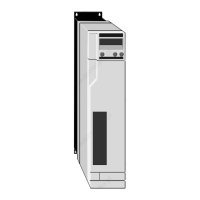
Do you have a question about the Digitax DBE140 and is the answer not in the manual?
| Brand | Digitax |
|---|---|
| Model | DBE140 |
| Category | Controller |
| Language | English |
Explains the Drive's power circuits, AC supply, and control via keypad or serial port.
Explains the meaning of warning, caution, and note symbols for safety hazards and product damage.
Warns about severe electric shock and lethal voltages from the Drive's internal components.
Highlights the Drive's role in systems and the need for trained personnel for safe installation.
Installer's responsibility for national/international wiring, safety, and EMC regulations.
Discusses stopping functions, unexpected starting hazards, and load conditions for personnel safety.
Emphasizes risk analysis for malfunctions causing damage or injury, suggesting backup systems.
Warns about parameter changes' profound effects and the need to prevent tampering.
Details available DigitAx models, their case sizes, power ratings, and current ratings.
Details RS485 protocol, timing for write/read operations.
Lists electrical specifications for resolver input, including voltage, frequency, and impedance.
Outlines conditions for meeting EMC requirements for conducted emissions and immunity.
Provides power ratings for typical 3-phase motors and notes on displacement factor.
Guidelines for minimizing radio-frequency emissions via enclosure and wiring.
Instructions for mounting RFI filters and connecting AC power cables.
Recommendations for connecting motor cables, including shielded types and length limits.
Describes wiring for resolvers and simulated encoders using screened cables.
Guidance on connecting analog speed references, emphasizing shielded twisted-pair cables.
Details requirements for ground connections using bus-bars.
Provides a procedure for planning installation based on environment and mounting type.
Shows recommended connections, ground arrangements, and minimum requirements for noise immunity.
Recommends suitable protection for AC supply, shows fuse ratings and cable sizes.
Explains the purpose of braking resistors and the risks involved.
Recommends thermal overload protection relays for braking resistor circuits to prevent overheating.
Provides steps to calculate required value and power rating for braking resistors.
Provides a procedure for navigating and displaying parameters and their values.
Details the procedure for editing parameter values, including security constraints.
Guides on setting up a security code to protect parameters from unauthorized access.
Describes approximate jumper locations on the SD200 board and default settings.
Provides instructions for entering parameter values for correct operation and optimization.
Introduces protection parameters like Pr42 (Maximum current) and Pr45 (Maximum continuous current).
Details full-scale speed calibration using analog input and potentiometers.
Provides a procedure for resolver phasing to ensure correct motor rotation.
Outlines commissioning steps, including connecting motor, checking display, and verifying signals.
Details the calibration procedure for optimizing system parameters and adjusting settings.
Outlines three methods for speed reference: Analog, Digital, and Frequency input.
Warns to set parameter b2 to 0 before changing speed control methods.
Details setting up the Drive for analog speed control using ±10V terminals.
Explains controlling speed via values in Pr0-Pr3, selected by methods like Direct or Sequential.
Lists three methods for running the Drive in torque control: Analog input, Digital input, and External torque link.
Warns to disable the Drive and ensure the motor is stopped before selecting torque control.
Describes controlling motor torque via analog reference on B9/B10 for master/slave applications.
Explains controlling torque via parameter Pr8 as a percentage of Imax.
Details controlling maximum speed while in torque mode, using torque input signal.
Explains position control using the 32-bit buffer and three methods: Pulse, Digital, Fixed Increment.
Describes controlling position via pulse-train on C7 and direction on C8.
Explains entering position reference via Pr75/Pr76 using serial communications.
Describes stopping motor at a predefined position using analog or digital speed reference.
Lists variable parameters with their default values, units, and names.
Provides write protection for parameters and refers to security setup.
Sets the maximum speed limit, triggering an over-speed trip if exceeded.
Allows serial communication control of position reference using Pr75 and Pr76.
Lists bit parameters, their default values, effects, and names.
Enables or disables the Drive.
Indicates overspeed trip condition.
Saves new parameter values from RAM to EEPROM.
Lists variable parameters with their default values, units, and names.
Lists bit parameters with default values, effects, and names.
Lists trip codes and their descriptions, including OU, UU, OC, th, rb, It, PA, OS, SC, Et, Err/dOI.
Provides a table of conditions, causes, and actions for troubleshooting common faults.
Explains using serial communications for parameter editing and control via host or PLC.
Details RS485/RS422 wiring, differential lines, and multi-drop links.
Explains setting up serial port parameters like Baud rate and format.
Outlines the components of serial messages: control characters, address, identifier, data, BCC.
Explains message formats for interrogating the Drive and sending commands.
Details message format for writing data to the Drive and expected responses.
Describes Terminal mode using a simplified protocol for direct communication.
Lists common Terminal mode errors: Parameter not recognised, Value out of range, Too many characters, Read-Only Parameter.
Lists parameters controlling serial communication settings like Drive Address and Baud Rate.
Explains how to set PID gains (Proportional, Derivative) using oscilloscope waveforms.
Guides on evaluating PID gains based on theoretical analysis and practical experience.
Guides on calculating the required integral gain based on acceleration and stiffness.
Provides a formula to calculate proportional gain based on nominal and peak current.
Provides a formula to calculate derivative gain, noting damping factor.
Explains how to adjust the speed loop bandwidth limit using Pr7.
